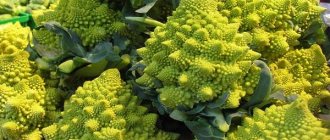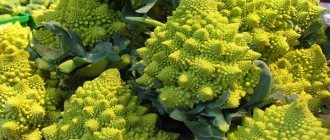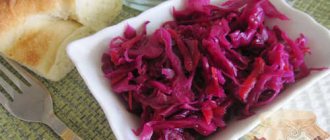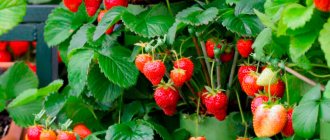White cabbage
This is the same type of cabbage that is most common in our country. As it matures, its leaves curl into a large, dense head of cabbage. Research has shown that this vegetable contains a whole range of useful substances, including the rare vitamin U. White cabbage is consumed both fresh and pickled (salted).
cabbage
The types of cabbage that form dense heads of cabbage vary in size, color and leaf structure.
White cabbage
White cabbage is traditionally popular in Russia: photos show it in all its diversity. This vegetable contains large amounts of vitamins K and C, as well as folic acid; Cabbage phytosterols regulate cholesterol production, improve the functioning of the digestive system and prostate gland.
Heads of cabbage vary in parameters:
- weight – from 1 kg to 20 kg;
- shape – flat-round, round, oval or cone-shaped;
- density strong or moderate;
- external color is green, gray or bluish;
- The inner leaves are cream or snow-white.
There are three groups of white cabbage varieties according to ripening time and purpose:
- Early ripening (about 3 months pass from germination to harvesting) - for fresh consumption, first and second courses. The best early varieties of white cabbage - names: Tochka, Start F1, Kazachok F1, Transfer F1, Hermes F1, Pandion F1, Nozomi F. They are loose, but relatively resistant to cracking and gain weight by 1-2 kg. Overfeeding with nitrogen should not be allowed.
- Mid-season and mid-late (grow for 4-5 months) - suitable for any dishes, good for pickling. The heads of cabbage are dense, juicy, and large. Popular varieties: Krautkaiser cabbage, Rinda F1, SB F1, Vyuga, Podarok.
- Late (vegetate for 5-6 months) - for long-term storage: dense, medium size, with a high dry matter content. Dutch varieties of white cabbage hold up well until the new harvest: Galaxy F1, Lennox F1, Expect F.
Planting density per 1 sq. m for white cabbage is: 3-4 pieces for the middle and late ones, 5-7 pieces for the early ones.
Red cabbage
Purple cabbage, as red cabbage is sometimes called, is very useful. It is distinguished by a high content of anthocyanins (cancer prevention) and vitamin K (strengthens bones and blood vessels). The leaf of the red cabbage plant is dense and harsh, and has a unique taste. The appetizing color and benefits are better preserved in fresh salads and cold marinades.
Modern varieties:
- early (weight 1-3 kg) – Faberge, Benefit F1, Primero F1, Red Jewel F1;
- late (excellently stored) - Otrada F1, Rondal F1, Fuego F.
Savoy
This species has unique healing properties due to the accumulation of ascorbigen, a special substance that is effective in the prevention and treatment of oncology. Savoy cabbage has loose heads (weight 1-3 kg), and the leaves are bubbly, with a delicate sweetish taste. Culinary uses: fresh salads, soups and stews; Great stuffing for cabbage rolls and pies. Savoy cabbage can be stored on the root under the snow and taken as needed.
The best varieties of cabbage for central Russia are not too late, with a rapid growth of the head of cabbage. For example:
- Golden early;
- Petrovna;
- Melissa F1;
- Sphere F
The agricultural technology of red and savoy cabbage is similar to white cabbage.
Brussels
Brussels sprouts produce small (2-4 cm in diameter) heads of medium density on a strong stem half a meter high. Their number on one plant varies from 20 to 60 pieces, with a total weight of up to half a kilogram. The color of the heads is green or purple. Gourmets praise their delicate taste, nutritionists praise the abundance of protein, omega acids, vitamins and minerals, and doctors praise their benefits for diabetes and digestive diseases. Heads of cabbage are consumed boiled or stewed, or frozen for future use.
Brussels sprouts are not easy to grow: we select the seeds and the best varieties for open ground especially carefully. Late-ripening varieties do not have time to fully form heads in the conditions of the Middle Zone and Siberia.
Preferred mid-season:
- Funny company;
- Garnet bracelet F1;
- Casio;
- Rosella;
- Franklin F.
We sow seeds for seedlings as early as possible, and at the end of summer we pinch off the tops of the stems. Plants need abundant watering and fertilizing.
Red cabbage
Externally, such cabbage differs from white cabbage only in color - it is purple with a red tint. This species acquires a specific leaf color due to the high content of a special substance – anthocyanin. Red cabbage has a beneficial effect on the cardiovascular system, increases the elasticity of blood vessels, and normalizes blood pressure.
Colored
In cauliflower, the nutritional value is represented by a dense, tuberous head (weighing from half a kilogram to three or more), consisting of shoots and rudimentary inflorescences. It is an important source of vitamins (C, B5, B9, K), iron, omega-3 linolenic acid, pectin, and digestible proteins. The vegetable is consumed boiled and stewed, frozen and pickled.
Traditionally, the head is creamy-white, but breeders have also developed bright types of cauliflower: photos, seed names demonstrate the range of colors:
- snow-white (Whitexel F1);
- light green (Emerald Cup);
- orange (Yarik F1);
- purple (Graffiti F1).
Early ripening forms are ready for harvesting 3 months after germination, late giants - a month and a half later. Productive hybrids (weighing 2-4 kg) are becoming increasingly popular. The crop requires increased nitrogen nutrition with the addition of potassium, phosphorus and (necessarily) boron - this complex is provided by manure fertilizers or special mineral fertilizer. Regular watering is required.
Decorative
This is the most beautiful type of cabbage, because as it ripens, it forms colored “rosettes” of unprecedented beauty. The central leaves curl in such a way that they resemble a rosebud. At the same time, they are painted in rich, bright colors depending on the specific subspecies. There are purple, white, milky, pink shades. This cabbage is often used as flowers, but can be eaten.
Broccoli umbrellas
Broccoli is very similar to colored broccoli - the same inflorescences, only green. Therefore, these two varieties of cabbage can often be found in one dish - the white and green mix of fluffy umbrellas looks very elegant.
In terms of its composition, broccoli is also not inferior to its other counterparts - it traditionally contains a lot of vitamin C, but it also contains methionine. This substance is useful in that it helps a person resist radiation and increase performance. The vegetable also contains many anti-sclerotic substances that prevent the aging of the body.
Broccoli is also unpretentious and will grow well in any garden. The main thing is to water it abundantly while the heads are growing. Unlike colored ones, there is no need to shade it. And the planting will withstand frosts down to -7.
Chinese
Chinese cabbage or Pak Choy (bok choy) bears little resemblance to cabbage, since it does not have a head of cabbage - only leaves collected in a large rosette up to 65 cm high, and a fleshy stalk.
This annual crop has a number of advantages:
- high germination;
- undemanding to soil composition;
- cold resistance.
Pak choy has only recently been grown in Russia, so few varieties are known:
| Name of variety or hybrid | Description and characteristics |
| Stonefly | Ultra-early variety, ready for harvest within 25 days after planting |
| Alyonushka | An early-ripening variety with a medium-sized rosette and dense green stalks |
| Swan | Mid-season Pak-choi with a growing season of 45 days. The swan grows up to 50 cm and gains weight up to 1 kg. The petioles are white, large and juicy. The variety is not afraid of crowded spaces and sudden temperature changes |
| Peahen | A hybrid obtained by crossing Chinese and Chinese cabbage. Its leaves and juicy, dense cuttings are edible. It is considered mid-season, but can be sown at any time, since it is resistant to early flowering. |
Kale (aka kale, grunkol or browncol)
Annual plant. It is believed that it is kale that most closely resembles wild cabbage, which now does not exist and is the “predecessor” of all “cultivated” species. Does not form a head of cabbage. Leaf shape and size vary widely.
Kale is a “loose” rosette of leaves on a tall (40 cm to 1 m) stem. Only they are edible; the stem is excessively hard and tasteless. The taste improves significantly if the plants are exposed to frost - the leaves become sweeter and juicier.
Calais:
- brings up to 500-700 g of greenery per plant;
- can be eaten raw, added to salads, soups, even “green” smoothies, dried, turning into healthy “chips”;
- most in demand in the Netherlands, Germany, Belgium, Japan.
Kale seedlings are easy to “identify”: even very young leaves have “curly” or corrugated edges.
Japanese
Cabbage of this type is more like a salad; it is not only edible, but also a medicinal vegetable, since it is capable of:
- improve digestion;
- prevent the appearance of tumors;
- strengthen immunity;
- Thanks to its low calorie content, it successfully fights excess weight.
In Russia, 2 varieties of Japanese cabbage were obtained:
| Name of variety or hybrid | Description and characteristics |
| Mermaid | A variety that requires 70 days to ripen. The plant is a lush “bouquet” of 35-40 carved bright green leaves. The weight of green mass reaches 1.8 kg. Mermaid is considered a mid-season variety, but it can be grown from late March until late autumn |
| Dude | A variety characterized by an ultra-short ripening period. Only 35 days, after which you can enjoy a salad of tender green leaves with a lilac tint. One plant produces an average of 400 g of greens. After cutting, the leaf grows back, which makes it possible to harvest several times per season. |
Savoy
Bred in the Italian county of Savoy. The leaf plates are very thin, highly corrugated, “bubbly” or “crumpled”. Because of this, the heads of cabbage are not particularly dense, even “loose.” They are no different in keeping quality.
The color is various shades of green, a silver tint is typical, the core is yellow. The taste is sweetish, the texture is delicate. This is due to the almost complete absence of coarse “fibers” in the tissues and the reduced concentration of mustard oils.
Savoy:
- small weight - 0.8-2 kg;
- very good fresh, as a filling for baked goods, in principle, suitable for homemade preparations, but unsuitable for fermentation; during heat treatment, if “overexposed” in a saucepan or frying pan, it turns into an unappetizing slippery mass;
- The largest plantations in area are located in Northern and Western Europe and North America.
It takes root in saline soil and has the ability to “desalinate” it.
Juicy Beijing
This is both cabbage and lettuce, since its elongated head of cabbage is perfectly divided into tender, crispy, juicy leaves. It is often used fresh, although Beijing can be stewed and fried. It is also perfect for Asian-style marinating in vinegar.
Gardeners already know what problems there are with this crop and skillfully avoid them. You can sow it directly into the ground, where it will ripen in 2 months, and it is better to sow it early, in April or May, otherwise it will go into arrows and will not produce the desired head of cabbage.
Outlandish kohlrabi
This vegetable looks more like a turnip, but don’t let that surprise you - turnips and cabbage are actually close relatives. In fact, the round head of kohlrabi is a stem fruit, that is, the plant has a ball-shaped stem with leaves on top, which is eaten. This ball is very tender and juicy, similar in taste to white cabbage, but without its bitterness.
Kohlrabi contains even more vitamin C than citrus fruits, which makes it an important and valuable product. The vegetable is also rich in fructose, potassium, glucose, vitamins PP, B2 and other elements.
Growing it is also not difficult, you can sow the seeds directly into open ground and harvest in 2-2.5 months, the main thing is not to miss this moment and harvest while the vegetable is still tender and juicy and has not hardened. Kohlrabi stores well, which is why it is so loved by gardeners.
Romanesco cabbage
One of the cultivated subspecies (varieties) of cauliflower, bred at the end of the twentieth century in Italy, is called Romanesco cabbage (name options - Roman, Italian). Its inflorescences are light green in color and visually appear as either spiky cones, or pointed cones, or a cluster of spiral seashells - which is why Romanesco has a very decorative appearance.
This cabbage has a delicate texture and a soft, creamy, nutty flavor without a bitter note. This vegetable is rich in vitamins C and K, dietary fiber and carotenoids. In general, the chemical composition and effect of this product on the body is similar to the effect of broccoli and cauliflower. And they prepare it in the same way as these types, although in their native Italy there are special recipes for Romanesco cabbage (frittata, orecchiette, etc.).
Popular Romanesco varieties
Pearl. Russian mid-late variety. The head is of medium density and size (up to 0.8 kg), green, round-flat in shape, consists of fused inflorescences of various sizes. The variety is moderately resistant to diseases.
Emerald Cup. Russian mid-early variety. The head is dome-shaped, light green in color, medium density, weighing up to 0.5 kg.
Puntoverde. Dutch powerful mid-early variety with bright green dense heads weighing up to 1.5 kg. Has nonspecific resistance to fungal diseases. Due to the fact that the inflorescences are slightly rounded, cabbage is less damaged during harvesting and transportation.
Brussels sprouts
This variety is perhaps the most exotic in appearance, just look at the photo of this vegetable. Brussels sprouts grow in clusters, small dark green heads attached to a long stem. It is much more bitter than its relatives due to the content of a large amount of mustard oils.
Growing Brussels sprouts in the garden is quite possible - they easily tolerate frosts down to -7 degrees and lack of moisture thanks to their powerful root system. But it takes a long time to ripen and, in comparison with ordinary cabbage, gives a small harvest, because... Only small heads of cabbage are considered to be them.
Brussels sprouts are added to soups, fried, stewed, pickled, and thanks to their dense heads, they freeze well.











